批评性语篇分析及其应用
- 格式:pdf
- 大小:106.96 KB
- 文档页数:1
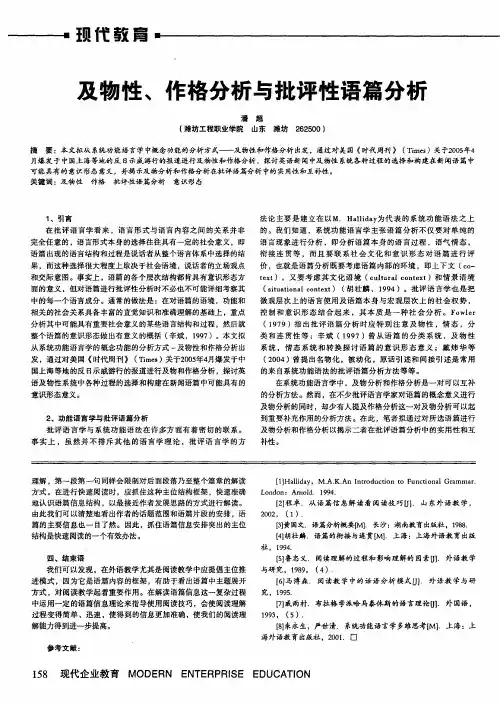
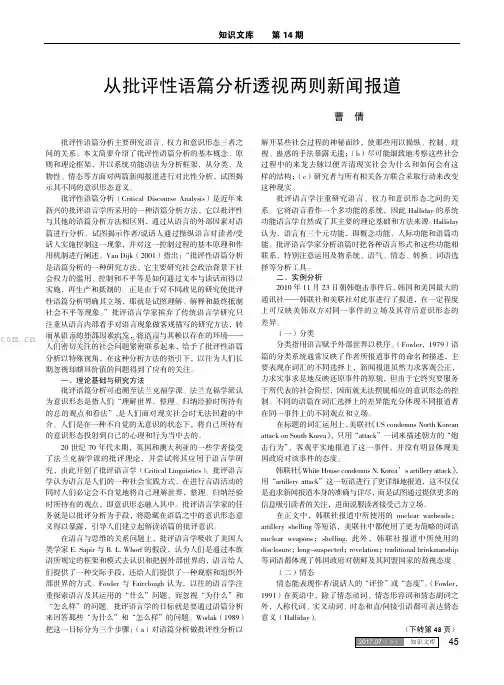
从批评性语篇分析透视两则新闻报道曹倩批评性语篇分析主要研究语言、权力和意识形态三者之间的关系。
本文简要介绍了批评性语篇分析的基本概念、原则和理论框架,并以系统功能语法为分析框架,从分类、及物性、情态等方面对两篇新闻报道进行对比性分析,试图揭示其不同的意识形态意义。
批评性语篇分析(Critical Discourse Analysis)是近年来新兴的批评语言学所采用的一种语篇分析方法,它以批评性与其他的语篇分析方法相区别,通过从语言的外部因素对语篇进行分析,试图揭示作者/说话人通过操纵语言对读者/受话人实施控制这一现象,并对这一控制过程的基本原理和作用机制进行阐述。
Van Dijk(2001)指出:“批评性语篇分析是语篇分析的一种研究方法,它主要研究社会政治背景下社会权力的滥用、控制和不平等是如何通过文本与谈话而得以实施,再生产和抵制的。
正是由于对不同政见的研究使批评性语篇分析明确其立场,那就是试图理解、解释和最终抵制社会不平等现象。
”批评语言学家摈弃了传统语言学研究只注重从语言内部着手对语言现象做客观描写的研究方法,转而从语言的外部因素出发,将语言与其赖以存在的环境——人们密切关注的社会问题紧密联系起来,给予了批评性语篇分析以特殊视角,在这种分析方法的指引下,以往为人们长期忽视却颇具价值的问题得到了应有的关注。
一、理论基础与研究方法批评语篇分析可追溯至法兰克福学派。
法兰克福学派认为意识形态是指人们“理解世界,整理、归纳经验时所持有的总的观点和看法”,是人们面对现实社会时无法回避的中介。
人们是在一种不自觉的无意识的状态下,将自己所持有的意识形态投射到自己的心理和行为当中去的。
20世纪70年代末期,英国和澳大利亚的一些学者接受了法兰克福学派的批评理论,并尝试将其应用于语言学研究,由此开创了批评语言学(Critical Linguistics)。
批评语言学认为语言是人们的一种社会实践方式,在进行言语活动的同时人们必定会不自觉地将自己理解世界,整理、归纳经验时所持有的观点,即意识形态融入其中。
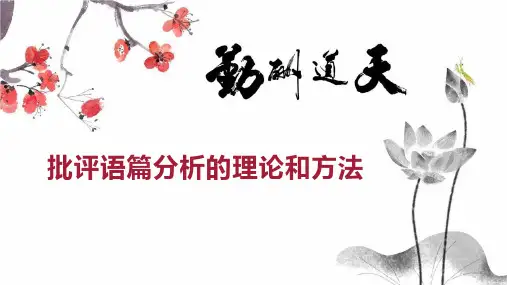
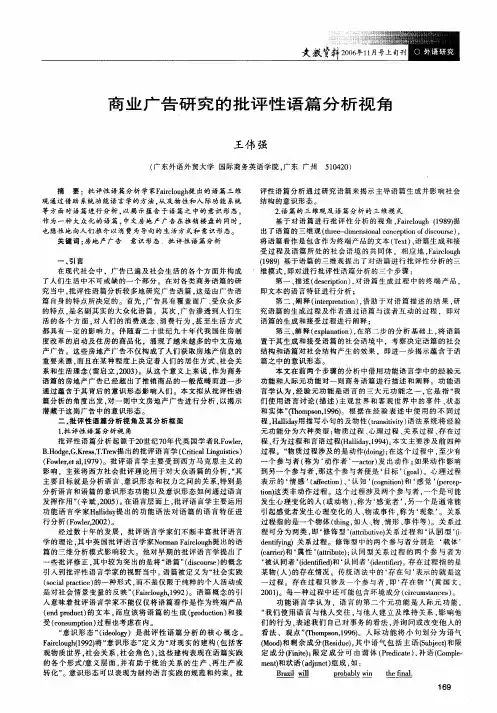
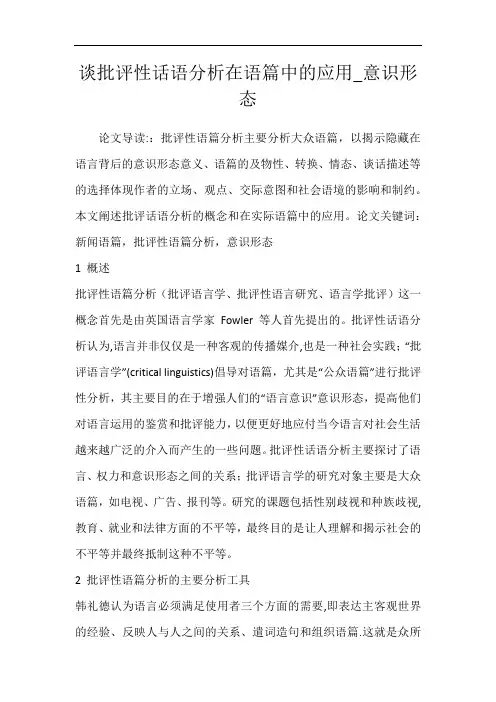
谈批评性话语分析在语篇中的应用_意识形态论文导读::批评性语篇分析主要分析大众语篇,以揭示隐藏在语言背后的意识形态意义、语篇的及物性、转换、情态、谈话描述等的选择体现作者的立场、观点、交际意图和社会语境的影响和制约。
本文阐述批评话语分析的概念和在实际语篇中的应用。
论文关键词:新闻语篇,批评性语篇分析,意识形态1 概述批评性语篇分析(批评语言学、批评性语言研究、语言学批评)这一概念首先是由英国语言学家Fowler 等人首先提出的。
批评性话语分析认为,语言并非仅仅是一种客观的传播媒介,也是一种社会实践;“批评语言学”(critical linguistics)倡导对语篇,尤其是“公众语篇”进行批评性分析,其主要目的在于增强人们的“语言意识”意识形态,提高他们对语言运用的鉴赏和批评能力,以便更好地应付当今语言对社会生活越来越广泛的介入而产生的一些问题。
批评性话语分析主要探讨了语言、权力和意识形态之间的关系;批评语言学的研究对象主要是大众语篇,如电视、广告、报刊等。
研究的课题包括性别歧视和种族歧视,教育、就业和法律方面的不平等,最终目的是让人理解和揭示社会的不平等并最终抵制这种不平等。
2 批评性语篇分析的主要分析工具韩礼德认为语言必须满足使用者三个方面的需要,即表达主客观世界的经验、反映人与人之间的关系、遣词造句和组织语篇.这就是众所周知的语言的三大“纯理功能”(metafunction):“概念”(ideational)功能,“人际”(interpersonal)功能,“语篇”(textual)功能。
概念功能指的是语言对人们在现实世界,包括内心世界中的各种经验或经历的表达龙源期刊。
就是说,语言通过这种功能来反映主观和客观世界中所存在的事物和发生的事件。
人际功能指的是语言反映人与人之间的关系,表达说话者的身份、地位、态度、动机和他对事物的推断等的功能。
语篇功能指的是把信息和语言成分组织成为连贯的语篇并把它与语境相联系的功能。


语言文学研究Hart批评性语篇分析理论评述刘贻珍(吉林大学,吉林长春130012)摘要:近年来,越来越多的学者从不同角度对语篇进行批评性研究,批评性语篇分析理论呈现跨学科发展趋势,先后涌现出批评认知语言学、多模态批评性语篇分析等理论。
Hart作为兰卡斯特学派的代表人物之一,在批评性语篇分析理论融合领域成绩斐然。
本文从功能语法、多模态、认知语言学三个层面阐述Hart相关理论的来源及应用,指出Hart相关理论的创新点及不足之处,为后续研究提供依据。
关键词:Hart批评性语篇分析功能语法认知语言学一、引言以往的批评性语篇研究主要通过分析话语揭示语篇背后蕴含的意识形态。
随着话语形式的日益多样化,语篇日趋复杂化。
越来越多的语言学家尝试通过运用其他语言学分支的相关理论,从多角度、多层次对语篇进行批评性研究!在这种情况下,批评认知语言学、多模态批评性语篇分析等理论应运而生。
近年来英国兰卡斯特大学教授H a rt致力于批评性语篇分析融合理论的研,的。
从语、多态、认知语言学面论述H a rt相关理论的来源,并通过实例阐明相关理论的应用,为后续研究的二、功能语法层面Hallida y的系统功能语法中的许多语法模型可应用到批评性语篇研究过!这在许多方面在通点(Young and Harrison,2004)。
首先,两者都将语言看作源。
其次,认语言语行意达,语言和语的关系是辩证的,由交际情境控制。
最后,在分析语言意的语言的言语的。
语的三大语言在批评性语篇研究应用,于语篇的在大度依赖概念功能和人际功能,本文将着重阐述概念功能和人在批评性语篇分析中的应用。
1.概念功能以概念功能为基础,Hart(2014:19-30)重点运用系统功能语的性和语态阐语言后的意识形态。
他,性在度语篇的真实意图。
性意的,用来分析的式,从而阐式的意识形态。
Hart认,性分析的在于对过行分析,过程类特的角。
例如,过程通在:受,而言语过则在说话接收。
阐明及物性如何反映语篇的意识形态,Hart (2014&24)对1984年一1985年英国矿工大罢工的相关新闻语篇进行性分析。
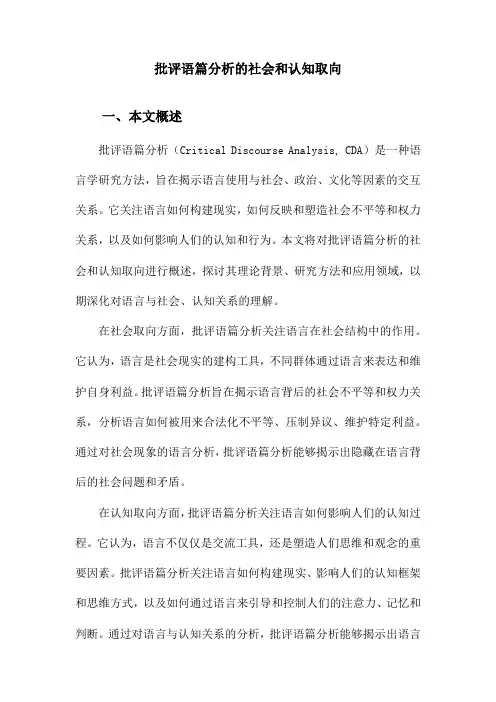
批评语篇分析的社会和认知取向一、本文概述批评语篇分析(Critical Discourse Analysis, CDA)是一种语言学研究方法,旨在揭示语言使用与社会、政治、文化等因素的交互关系。
它关注语言如何构建现实,如何反映和塑造社会不平等和权力关系,以及如何影响人们的认知和行为。
本文将对批评语篇分析的社会和认知取向进行概述,探讨其理论背景、研究方法和应用领域,以期深化对语言与社会、认知关系的理解。
在社会取向方面,批评语篇分析关注语言在社会结构中的作用。
它认为,语言是社会现实的建构工具,不同群体通过语言来表达和维护自身利益。
批评语篇分析旨在揭示语言背后的社会不平等和权力关系,分析语言如何被用来合法化不平等、压制异议、维护特定利益。
通过对社会现象的语言分析,批评语篇分析能够揭示出隐藏在语言背后的社会问题和矛盾。
在认知取向方面,批评语篇分析关注语言如何影响人们的认知过程。
它认为,语言不仅仅是交流工具,还是塑造人们思维和观念的重要因素。
批评语篇分析关注语言如何构建现实、影响人们的认知框架和思维方式,以及如何通过语言来引导和控制人们的注意力、记忆和判断。
通过对语言与认知关系的分析,批评语篇分析能够揭示出语言如何影响人们的思维和行为,进而揭示出语言与认知之间的复杂关系。
本文将对批评语篇分析的社会和认知取向进行详细介绍,包括其理论背景、研究方法和应用领域。
通过本文的阐述,读者将能够更深入地了解批评语篇分析的基本概念和理论框架,以及其在社会、政治、文化等领域的应用价值。
本文还将探讨批评语篇分析所面临的挑战和未来发展方向,以期推动该领域的深入研究和应用。
二、批评语篇分析的社会取向批评语篇分析的社会取向着重于语言与社会结构、权力关系以及意识形态的紧密联系。
在这一取向中,语言被视为一种社会实践,通过话语的构建和传播,反映并塑造着社会的各种关系和权力结构。
批评语篇分析的社会取向强调了话语的社会功能和影响,特别是话语如何参与塑造社会不平等、歧视和压迫等问题。
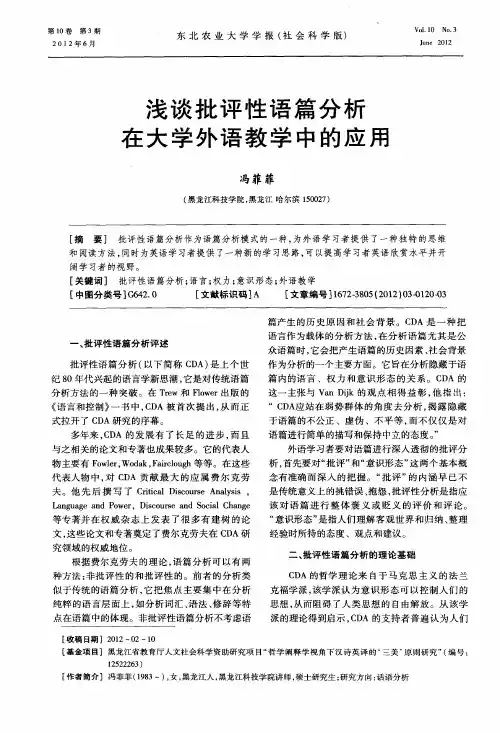

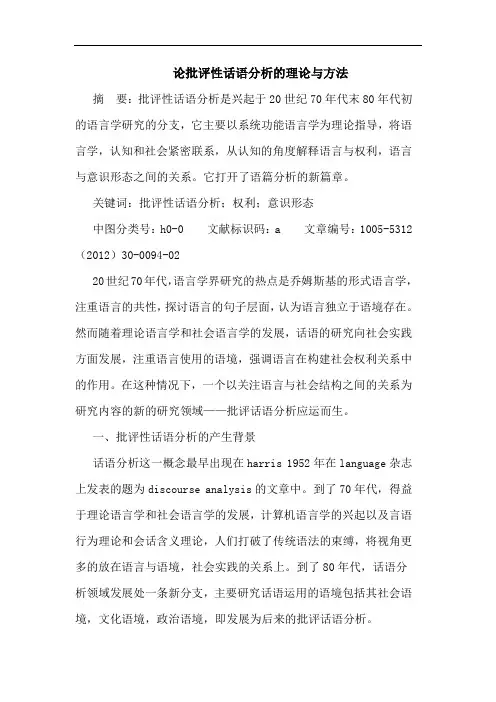
论批评性话语分析的理论与方法摘要:批评性话语分析是兴起于20世纪70年代末80年代初的语言学研究的分支,它主要以系统功能语言学为理论指导,将语言学,认知和社会紧密联系,从认知的角度解释语言与权利,语言与意识形态之间的关系。
它打开了语篇分析的新篇章。
关键词:批评性话语分析;权利;意识形态中图分类号:h0-0 文献标识码:a 文章编号:1005-5312(2012)30-0094-0220世纪70年代,语言学界研究的热点是乔姆斯基的形式语言学,注重语言的共性,探讨语言的句子层面,认为语言独立于语境存在。
然而随着理论语言学和社会语言学的发展,话语的研究向社会实践方面发展,注重语言使用的语境,强调语言在构建社会权利关系中的作用。
在这种情况下,一个以关注语言与社会结构之间的关系为研究内容的新的研究领域——批评话语分析应运而生。
一、批评性话语分析的产生背景话语分析这一概念最早出现在harris 1952年在language杂志上发表的题为discourse analysis的文章中。
到了70年代,得益于理论语言学和社会语言学的发展,计算机语言学的兴起以及言语行为理论和会话含义理论,人们打破了传统语法的束缚,将视角更多的放在语言与语境,社会实践的关系上。
到了80年代,话语分析领域发展处一条新分支,主要研究话语运用的语境包括其社会语境,文化语境,政治语境,即发展为后来的批评话语分析。
二、批评话语分析的概念及理论基础批评性话语分析是现代语言学研究的一个新的分支,兴起于20世纪70年代末80年代初,是一门旨在研究和解释社会问题的跨学科语言研究。
而批评语言学强调语言是一种社会实践,语言的研究离不开社会,语言反映与构建社会结构。
批评语言学不仅研究语言的外表,还研究语言的内涵,不仅对语篇的意义感兴趣,还对语篇如何产生这种意义的过程感兴趣。
批评性话语分析受西方马克思主义哲学的影响。
另外,阿尔都塞的意识形态理论和福特的权力话语理论也对批评性话语分析的发展提供了重要的哲学基础。
批评性话语分析篇一:批评性话语分析● 杜 婷批评性话语分析(Critical Discourse Analysis, CDA)是20世纪70年代末期语篇分析领域发展起来的一个重要的研究方向和研究方法。
1979年R.Fowler、B.Hodge、G.Kress和T.Trew出版了《语言与控制》(Language and Control)一书,提出批评语言学的分析方法,旨在通过对大众语篇的分析,来揭示意识形态对语篇的影响和语篇对意识形态的反作用。
①在分析方法上,批评性话语分析坚持以M.A.K.Halliday的系统功能语法作为分析工具,通过观察语言特点和它们生成的历史背景来解释语言结构背后的意识形态意义,进而揭示语言、权利和意识形态之间的关系。
其主旨是要透过语言形式来揭露意识形态对话语的影响,以及话语对意识形态的反作用。
②随着批评性话语分析研究的深入,新闻语篇作为批评话语分析的一个重要研究领域,受到越来越多的关注。
今天,以英语为媒介的大众传播媒体日益渗透到国际社会的方方面面,英语新闻每天都在影响着世界舆论。
新闻报道从来就不是绝对客观公正的,许多新闻语篇看似客观公正,实则含而不露地表达了各种意识形态意义,对读者产生着潜移默化的影响。
③本文从情态、直接和间接引语、转换、词汇等角度,考察和揭示美国新闻报道背后起作用的意识形态,进而揭示美国媒体以及主流社会对中国认识的偏差。
文本分析2011年7月23日温州动车追尾事故发生后,国内外各大媒体对这次铁路交通事故进行了各种各样的报道。
美国的主流媒体一直宣称其新闻报道客观公正,然而事实并非如此。
本文以《纽约时报》官方网站上的一篇报道为文本,以批评性话语分析理论为基础,从情态、被动语态、直接和间接引语以及词汇等方面分析报道中所蕴涵的意识形态,从而揭示美国主流媒体对中国认识的偏差以及对中国国际形象的颠覆。
1.情态情态主要表达人际功能,分析新闻报道中的情态可以反映出作者的意识形态。
新闻语篇的批评性话语分析一、本文概述新闻,作为社会信息的传递媒介,不仅仅是传递事实的工具,更是塑造公众认知和意识形态的重要渠道。
在这个信息传播的过程中,新闻语篇的选择、编写、发布等各个环节都可能受到各种社会、政治、经济因素的影响,从而呈现出特定的意识形态色彩。
因此,对新闻语篇进行批评性话语分析,揭示其隐含的意识形态意义,成为了语言学研究的重要课题。
批评语言学,作为语言学的一个分支,旨在通过语言学的理论和方法,揭示语言与社会、文化、权力等因素的关系,以及语言在塑造人的社会身份和意识形态中的作用。
批评话语分析,作为批评语言学的重要组成部分,主要从分类、及物性、情态等角度对语言进行深入分析,以揭示语言背后所隐含的意识形态和权力关系。
本文运用批评语言学理论,对新闻语篇进行批评性话语分析,旨在揭示新闻报道所隐含的意识形态意义。
我们选取典型的新闻语料,从分类、及物性、情态等角度进行深入剖析,以揭示新闻报道是如何通过语言的选择和运用,来塑造公众的认知和意识形态。
我们也注意到,新闻语篇作为社会行为力量,其产生的社会、政治、经济背景也是不可忽视的。
因此,在进行分析时,我们也充分考虑了这些因素对新闻语篇的影响。
通过本文的分析,我们希望能够引导读者更加深入地理解新闻语言背后的意识形态意义,提高公众对新闻媒体的批判性思维能力,以更加全面、客观、理性的态度看待新闻报道。
二、批评性话语分析的理论基础批评性话语分析(Critical Discourse Analysis,简称CDA)是批评语言学在话语分析领域的具体应用,它以系统功能语言学为主要理论框架,深入探索语言、权力和意识形态之间的关系。
系统功能语言学认为,语言不仅是对现实的反映,而且是一种社会行为力量,能够构建、维持和改变社会关系。
因此,批评性话语分析的目的在于揭示语言在塑造人的社会身份、传递权力关系以及构建意识形态中的重要作用。
在批评性话语分析的理论框架中,分类(classification)、及物性(transitivity)和情态(modality)等概念被赋予了新的视角和深度。
《外国语》2004/5批评性语篇分析:问题与讨论辛斌(南京师范大学外国语学院江苏南京210097)摘要:作为一种话语分析方法,出现于80年代初的批评性语篇分析难免存在这样或那样的局限性,这从一开始就引起了人们的注意。
近几年对这种方法的批评在不断增加,其中大部分批评恰如其分,很有见地,值得CDA学者认真思考,但也有一些批评似乎有失公允,反映了批评者对CDA的期望值太高。
本文以斯塔布斯和威窦森为代表简单评述了人们对CDA 提出的一些主要批评。
关键词:批评性语篇分析、批评、讨论Critical Discourse Analysis: Criticism and DiscussionXin Bin(School of Foreign Languages, Nanjing Normal University)Abstract: As an approach to text/discourse analysis, critical discourse analysis (CDA) has been under constant criticism since its emergence in the 1980’s. Many of the criticisms are apt and illuminating, but some others are not so fair, showing that the critics might have expected too much from CDA.Key words: critical discourse Analysis, criticisms, discussion始自70年代末80年代初的“批评性语篇分析”(critical discourse analysis, 简称CDA;也叫“批评语言学”(critical linguistics))把传统上主要以文学语篇为对象的文体学分析技巧广泛应用于对非文学语篇的分析上,特别重视语言/语篇和社会结构之间复杂的相互作用关系。
《纽约时报》中涉华负面报道的批评语篇分析摘要批评语篇分析(CDA)是语篇分析研究的一种,主要研究语言、权利和意识形态之间的关系。
批评语言学家认为语言与其产生的社会语境呈辨证统一的关系。
我们进行批评语篇分析主要是要发现和分析语篇中那些人们习以为常的意识形态,以便对它们进行重新审视。
在CDA的发展过程中,媒体语篇倍受批评语言学家的关注。
报纸新闻是我们日常生活中一种重要的大众传媒方式。
新闻报道不仅能为读者提供信息并带来愉悦,而且更影响他们的感知,态度和行为。
在当今信息时代,人们主要是通过新闻媒体来认识一个国家,而美国媒体可以说是在当今世界居于主导地位的。
因此,美国新闻媒体的国际报道对一个国家的国家形象有着非常关键的影响作用。
美国主流媒体的涉华报道也是近年来学术研究的一个热点。
本文在颇有威望的《纽约时报》中选取了 2008年涉华的负面报道为素材,以费尔克劳的三维模式和韩礼德的功能语法相结合,进行分析研究。
论文证明在《纽约时报》的涉华报道中确实存在负面的态度。
而且,本文发现《纽约时报》在报道涉华新闻时反映负面态度的手法,大体可以分为功能手段,互文性及非语言手段这三大类。
通过对《纽约时报》语料的分析,可以看出新闻语篇价值负载的特性。
研究同时表明,语言结构在新闻的主张构建中起重要作用,新闻中常利用这一点来实现报纸的自身利益。
论文的意义在于帮助读者提高对那些隐晦的潜在的有失偏颇的文章批评阅读的意识,而不是被动的接受文本信息。
在掌握了这些常用手段后,读者可以理解新闻背后的真实意图。
关键词:批评性语篇分析;韩礼德功能语法;纽约时报;负面新闻报道iii CONTENTSAcknowledgements iAbstractii摘要 iiiChapter One Introduction. 11.1 The Background of the Study11.2 Purposes and Significance of the Study21.3 Data Collection 31.4 The Structure of the Thesis 4Chapter Two Literature Review. 52.1 The Development of Critical Discourse Analysis52.1.1 Key concepts and Principles of CDA 52.1.2 CDA Studies abroad 82.1.3 CDA Studies at Home. 102.2 Theoretical Framework..112.2.1 Fairclough's three-dimensional model.112.2.2 Halliday's Systemic-Functional Grammar 162.2.3 The Relationship between CDA and SFG. 242.3 Critical Discourse Analysis on News Report. 26Chapter Three A Critical Analysis of China-related Negative News Reports in New York Times. 283.1 The Definition of Negative New Report283.1.1 The Notion and Categorization of News 283.1.2 News Value293.1.3 News Sources313.1.4 Negative News Report 313.2 Functional Approach323.2.1 Transitivity 323.2.2 Transformation 373.2.3 Lexical Choice 413.2.4 Modality Choice 443.2.5 Thematic choice. 463.3 Intertextuality. 483.4 Non-linguistic Tools 533.4.1 Benefit-oriented Feature of News. 533.4.2 Historical Factor 533.4.3 Cultural Factor 55Chapter Four Conclusions. 574.1 Findings of the Study..584.2 Implications of the Study..594.3 Limitations of the Study.60 Bibliography. 60Appendix 64Chapter One Introduction1.1 The Background of the StudyCritical discourse analysis CDA, a research area that represents an outgrowth of the workof the British and Australian pioneers of critical linguistics, particularly Fowler and Kress, inconvergence with approaches of the British discourse analyst Fairclough and Dutch text linguistvan Dijk. CDA has produced the majority of the research into media discourse during the 1980sand 1990s, and has arguably become the standard framework for studyingmedia texts withinEuropean linguistics and discourse studies Bell&Garrett, 1998:5-6. CDA is a field that isconcerned with studying and analyzing written and spoken texts to reveal the discursive sourcesof power, dominance, inequality and bias. It examines how these discursive sources aremaintained and reproduced within specific social, political and historical contexts Van Dijk,1998At this Information Age, western mass media such as newspapers, English broadcasts, andso on, are made easily accessible to EFL learners in China. News is an important channel ofinformation transmission, which is usually presented as the unbiased recording of 'hard facts'However, previous studies made by critical linguists and some scholars in other fields prove thatit is not actually the case. According to Fowler 1991:12, news is a practice, a product of socialand political world on which it reports. He stresses the social nature of news. "News is theend-product of a complex process which begins with a systematic sorting and selecting of newsof events and topics according to a socially constructed set of criteria of news worthiness. "News reports relate closely to political and economic power, and are influenced by theofficial ideologies inevitably. The significance of language in news reports makes it necessaryfor us to do a critical discourse analysis of them, which can help to dig up the hidden meaningbehind the words. Therefore, the present study tries to conduct a study of news reports in NewYork Times from the perspective of CDAThen why choose the negative news reports about China? It is believed that the remarks about China made by one commentator of CNN, Jack Cafferty impressed and irritated a lot of1 Chinese people. It showed obviously negative attitude towards China. This is what we can see atthe very first sight of the news. However, not every piece of news expresses its position directlyMost of news reports need analyzing with a critical view. This is also what we are going to do inthis thesis, a critical discourse analysis of news reports As is known, in the year of 2008, a series of important events have happened in ChinaHuge snow damage in January and February, Tibet issues and TaiWan election in March, trainclash in April, Earthquake in May, flood in June and the Olympic Games in August, babyformula milk problem in September…All of these have drawn great attention both at home andabroad. News reports about China appear on the front pages of newspapers in different countriesTo the same event, different newspapers show different points of view. Among these reports, it is inevitable that some negative attitudes are revealedThis thesis focuses on the American newspaper New York Times NYT for its prestige andinfluence in the United States and worldwide. It is found that some reports reveal negativeattitude to China and express it directly by words such as the commentator of CNN, JackCafferty’s remarks on China. However, not every news report is so explicitly negative, butsometimes rather implicitly. So what devices are used by the NYT to give the readers a negativeimpression on China? This is what is discussed in this thesis. In order to understand theChina-related news in NYT better and learn what attitude America holdtowards China, thehidden meaning of the news reports needs digging up1.2 Purposes and Significance of the StudyThe purpose of this thesis is to analyze the negative China-related news reports in thenewspaper New York Times, an opinion-leading and with comparatively large circulationnewspaper in America and then to summarize and systematize the devices which are oftenconducted to convey the negative attitudes in the newspaper through critical discourse analysis inorder to show how the negative attitudes are directly or indirectly expressed. In a word, the thesisdiscusses how American newspaper New York Times reports China's issues and how it misleadsthe publicNewspaper is one of the important mass media in our daily life. Through the newspaper, wecan understand others' opinions and attitudes. The significance of the thesis is to help the readers2 to increase their critical awareness of potentially biased or prejudiced language instead ofaccepting the news passively. After grasping the often-used devices of negative reports, thereaders can get to know the real intention behind the news1.3 Data CollectionAll the China- related news reports for this thesis were selected from the famous newspaperNew York Times through Internet for its prestige and influence worldwide The New York Times is a daily newspaper published in New York City and distributedinternationally. The largest metropolitan newspaper in the United States, "The GrayLady"?named for its staid appearance and style?is regarded as a national newspaper of recordFounded in 1851, the newspaper has won 98 Pulitzer Prizes, more than any other newspaper. Itsmotto, as printed in the upper left-hand corner of the front page, is "All the news that's fit toprint." ////0>. times. htmlThe New York Times newspaper is considered as the most authoritative daily newspaper inthe US and arguably the most in the world. It is read and quoted by millions of people everydayand available in most libraries, US embassies, and consulates abroad. Along with USA Today andThe Wall Street Journal, it is one of the top 3 American newspapersin terms of readership andcirculation, with daily readership of about 5 million. It is one of the world's top hundred dailynewspapers based on circulation ////.times. 6>html. In this sense, the New York Times is a comparatively better choice for this thesis The political stance of NYT is liberal, i.e. left-leaning for Democratic Party. The newspaperis organized in three sections which are news, opinion and features. News includes International,National, Washington, Business, Technology, Science, Health, Sports, The Metro Section almostalways section B, Education, Weather, and Obituaries. Opinion includes Editorials, Op-Eds andLetters to the Editor. Features include Arts, Movies, Theater, Travel, NYC Guide, Dining &Wine, Home & Garden, Fashion & Style, Crossword, The New York Times Book Review, TheNew York Times Magazine, and Week in Review. Looking from its content, New York Times is acomprehensive newspaper with a wide news coverage including almost every aspect of thesociety and daily life ////. In view of the prestige of NYT in Americaand worldwide, many Chinese scholars have3 been studying its attitudes towards China. Their analysis focuses on reports of big and hot issuesin China, such as the quantitative analysis of Tibet issue by Fan Shiming. Yu Jiadi collects andanalyses the China-related news reports in NYT during Clinton's visit to China. And Chen Hanxianalyses the reports on the airplane clash issue, Huang Li collects the data about SARS toillustrate NYT's position on China-related issues. All these studies prove that a large amount ofnegative reports in NYT about China exist and influence the readers who may not realize it. Theword "Demonize" is used in China to refer to this kind of the reports on China in NYT. In theview of the author, these reports demonized China and tarnished its image in the eyes of theworld readership. And several often-used devices will be introduced and classified in furtheranalysis As mentioned above, a great many of events, good or bad, have happened during the year2008. As a result, China attracts more attentions of American mediathan before. And the newsreports concerning China are relatively rich and plentiful. Besides, we are living right in thiseventful time, so analysis of this year's newspaper can help us to get a deeper feeling andresonance. That's why the thesis selects the news reports during the whole year of 2008 in NYT Samples are selected according to the topics, including earthquake in Sichuan, Tibet issue,Jack Cafferty's comments, Taiwan problem, economic problem, Olympic Games, baby formulaissues and so on. Some representative data like Monk Protests in Tibet Draw Chinese Security;China Demands CNN Apologize for Commentary; Taiwan Elects a Supporter of CloserMainland Ties ; Powerful Quake Ravages China, Killing Thousands; China’s Leaders Try toImpress and Reassure World; Baby Formula Sickened Many More, China Says, etc. arediscussed in the thesis1.4 The Structure of the Thesis The thesis consists of four major parts. After the introduction and literature review, it comesto the main part, a detailed analysis of China-related negative newsreports in New York TimesUsing the framework developed in the previous chapters, the often-used devices in NYT whichimply the negative views are made implicitly and classified clearly. And it is helpful for learnersto achieve the goal of critical reading of the news media texts. However, due to the limitedanalyzing ability and other factors, the thesis has its own shortages and room for further studies4 Chapter Two Literature Review2.1 The Development of Critical Discourse Analysis2.1.1 Key concepts and Principles of CDA CDA is different from other discourse analysis methods because it includes not only adescription and interpretation of discourse in context, but also offers an explanation of why andhow discourses work. To learn more about CDA, except of the definition of itself, the keynotions should also be well graspedCDA concerns with the relationship between language, power and ideology therelationship between discourse, social identity and social change Fairclough, 1992a,b and therole of discourse in producing and maintaining inequality vanDijk,1991. Accordingly, textanalysis is only one aspect of discourse analysis in addition to the analysis of discursive practiceand social practice Fairclough, 1989, 19922.1.1.1CDADifferent scholars define CDA differentlyFairclough defines CDA as an approach which seeks to investigate systematically oftenopaque relationships of causality and determination between adiscursive practices, events andtexts, and b wider social and cultural structures, relations and processes; to investigate howsuch practices, events and texts arise out of and are ideologically shaped by relations of powerand struggles over power; and to explore how the opacity of these relationships betweendiscourse and society is itself a factor securing power and hegemony Fairclough,1995:135According to Ruth Wodak 1989, CDA is a discourse analysis "with an attitude”. Itfocuses on social problems, and especially on the role of discourse in the production andreproduction of power abuse or domination. In the most general sensethe object of research inCDA is the public sphere?that is, the social spaces and social practices where people as citizensengage in dialogue about issues of social and political concern Van Dijk 1998 holds that CDA is a field that is concerned with studying and analyzingwritten and spoken texts to reveal the discursive sources of power, dominance, inequality and5 bias. It examines how these discursive sources are maintained and reproduced within specificsocial, political and historical contextsFowler describes CDA in his Language in the News: Discourse Ideology in the Press as follows: Critical linguistics seeks, by studying the minute details of linguistic structure in thelight of the social and historical situation of the text, to display to consciousness the patterns ofbelief and value which are encoded in the language - and which are below the threshold of noticefor anyone who accepts the discourse as 'natural' Fowler,1991:67Critical linguistics is a socially directed application of linguistic analysis, using chieflyconcepts and methods associated with the "systemic-functional"linguistics developed byHalliday. It proposes that analysis using appropriate linguistic tools, and referring to relevanthistorical and social contexts, can bring ideology, normally hidden through the habitualization ofdiscourse, to the surface for inspection. In this way, critical linguistics can shed light on socialand political processes Malmkjaer & Anderson, 1991:147We can see that there are diverse views about CDA, but they "share a commitment to go beyond linguistic description to attempt explanation, to showing how social inequalities arereflected and created in language, and to finding ways through their work to change theconditions of inequality that their work uncovers." Pennycook, 1994:1212.1.1.2 CriticalFairclough distinguishes critical discourse analysis from non-critical one as follows: Criticalapproaches differ from non-critical approaches in not just describing, discursive practice, butalso showing how discourse is shaped by relations of power and ideologies, and the constructiveeffects discourse has upon social identities, social relations and systems of knowledge and belief,neither of which is normally apparent to discourse participants Fairclough, 1992b:13According to Fairclough 1992a, 'critical' implies showing connections and causes which arehidden; it is also implies intervention, for example, providing resources for those who may bedisadvantaged through changeThe word critical could be intended, to denote negative evaluation, but this negativity is notnecessarily the aim of critical linguistics. Critical linguistics simply means an enquiry into therelations between signs, meanings and the social and historical conditions that govern the6 semiotic structure of discourse, using a particular kind of linguistic analysis Fowler, 1991:5Critical discourse analysis is 'critical' in the sense that it aims to reveal the role of discursivepractice in the maintenance of the social world, including those social relations that involveunequal relations of power. Its aim is to contribute to social change along the lines of more equalpower relations in communication processes and society in generalLouise Phillips andMarianne W. Jorgensen, 2002:63 Within this framework of "critical," the analyst's intention is to uncover powerrelationships and demonstrate inequities embedded in society. In this framework, the analystmay believe that the uncovering of power relationships in their analysis may lead to disruptingthe power relations in the social contexts in which they study. They do not, however, includesuch political and social disruption in their analysis2.1.1.3 Discourse The term discourse has been defined differently by different scholars. Fairclough1992a:28 writes, "Discourse is, for me, more than just language use: it is language use, whetherspeech or writing, seen as a type of social practice". Kress 1985: 6 defines it as a systematicallyorganized set of statements which give expression to the meanings and values of an institution" Fairclough 1992b uses the term “discourse” to emphasize language use as a socialpractice rather than an individual practice and points to three important implications of thisFirstly, discourse is a mode of representing reality but also a mode of acting upon the world andpeople acting upon each other see also van Dijk 1997a. Secondly,language use as a socialpractice implies a dialectic relationship betw。